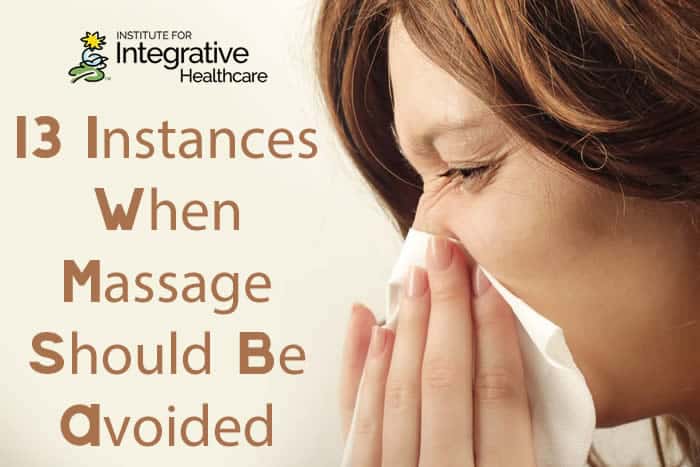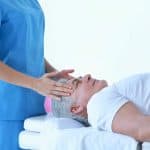

Massage therapists tend to focus on—and promote—the benefits of massage therapy, which are many, ranging from stress and pain relief to an array of positive effects on specific medical conditions.
There are also, though, instances where massage isn’t appropriate because of the risks involved. In some cases, massage is contraindicated only for an affected area—for instance, an open sore of any kind, bruises, and burns—but may be done for the rest of the body.
In some instances, however, massage should be avoided altogether because of the risks posed to those populations.
13 Conditions in Which Massage Should Not Be Given
- Fever. For a client with a fever of 100.4ºF or higher, any massage that might challenge his or her internal environment “is strictly contraindicated because the body is going through an acute healing process” (1). However, “very light massage . . . may help a client with a fever sleep better” (1).
- Colds and flus. While some massage therapists believe that, for clients in the early and acute stages of such illnesses, “massage can accelerate the onset of the infection and intensify its severity” (2), this isn’t the case, according to Tiffany Field of the Touch Research Institute who says that “massage boosts natural killer cells and natural killer cells kill cancer, viral and bacterial cells so there is no way that massage would exacerbate cold symptoms” (3). In fact, clients experiencing cold and flu symptoms should be rescheduled because of the risk they pose of infecting others, rather than any risk to themselves—although any congestion they were experiencing would certainly be made worse from lying face down in the face cradle.
- Liver failure. Massage is contraindicated for those in liver failure because “it increases the fluid returned to the blood from edema and/or ascites, which would further tax an already debilitated liver” (4). (“Ascites” is the accumulation of fluid in the peritoneal cavity, causing abdominal swelling.) In addition, there is potential for bruising in those with impaired livers because the liver combines many clotting factors.
- Blood clots. Because massage increases the risk of a blood clot being released (5), deep tissue massage should not be done. However, a past history of blot clots does not preclude massage (6). Dr. Brian Becker offers the reminder, though, that “strokes on extremities (arms and legs) should always be toward the heart to assist venous return” (6).
- Diabetes. If diabetic neuropathy (i.e., loss of sensation) is present, massage is contraindicated because the client is unable to tell if the pressure is too deep. Hot stone massage is also contraindicated because the client wouldn’t be able to sense if the stones were burning him or her (7). For diabetic clients not experiencing numbness due to nerve damage who are receiving a massage, any area where insulin has recently been injected should be avoided because “massage may accelerate insulin uptake” (5).
- Hemophilia or if blood-thinning medication is being taken. Hemophilia, a hereditary blood defect, “is marked by delayed clotting of the blood with prolonged or excessive internal or external bleeding after injury or surgery” (8). “Internal bleeding (in joints and muscles) can be caused by even a minor trauma to muscles and joints in people with severe and moderate hemophilia” (9). Clients who are taking blood thinners like Warfarin may also be more prone to internal bleeding, as well as bruising (10).
- Severe osteoporosis. Osteoporosis generally affects older people, especially women, and is characterized by a loss of bone density and mass, making bones very porous and fragile. For this reason, clients with severe or even moderate osteoporosis may be experience broken bones as a result of massage, especially deep work (5, 7).
- Severe platelet deficiency. Thrombocytopenia “is a condition in which your blood has a lower than normal number of blood cell fragments called platelets” (11). While massage is not completely contraindicated for people with this condition, it is imperative that no deep tissue work or trigger point therapy, for instance, be used as this could cause bruising or even extensive leakage of blood, known as hematomas (5).
- Intoxicated clients. Alcohol and recreational drugs impair a client’s ability to feel when a massage is too intense or too deep, increasing the possibility of being injured during a massage (12, 13). In fact, it’s not a good idea to massage someone the day after they’ve been drinking a lot: a client who is hungover and dehydrated will likely feel even more dehydrated after a massage (14).
- Autoimmune diseases. During inflammatory stages or acute flare-ups of autoimmune diseases such as rheumatoid arthritis, scleroderma, or lupus, massage should be avoided as the skin may be painful to the touch at such times (5).
- Cellulitis. A bacterial skin infection, cellulitis appears as a hot, red, tender area. Even though the red patch may be discrete, because this condition is often accompanied by malaise and fever, whole body massage is contraindicated (15).
- High-risk pregnancies. Because there are no scientifically agreed on guidelines for pregnancy massage, women who are at high risk of, for example, preeclampsia, miscarriage, or placental abruption should consult their doctors before receiving massage. And then massage should only be given by someone certified in pregnancy massage. Because of the risk, some therapists might require a liability waiver and written consent from the doctor before providing massage (16, 17).
- Meningitis. Meningitis, which affects the brain and spinal cord, is life-threatening to the client and may be contagious (9). Massage is therefore contraindicated when it is at an acute stage (18). During remission, however, massage can actually “lessen exacerbations, relax the client, decrease tone in rigid muscles, and prevent stiffness and contractures” (19).
Conclusion
The above list is by no means comprehensive. It does, however, point to why obtaining client histories is so important.
Equally important is to check with returning clients as to whether they have any new medical conditions or health concerns. The client’s safety and well-being is important, but your own health should be safeguarded, too.















